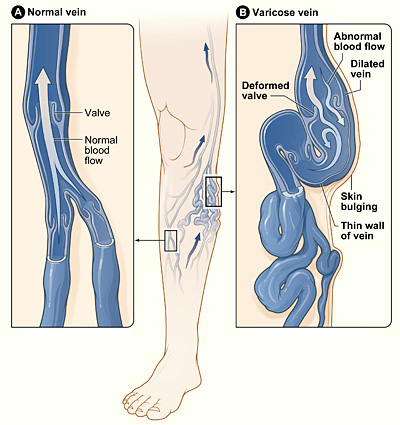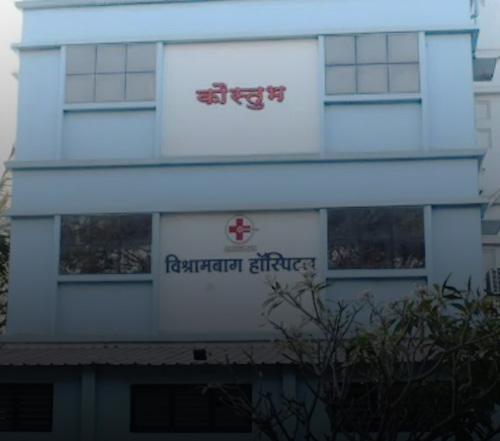"Absence of pain does not mean absence of disease!"
Varicose Veins is a very common problem usually neglected by patients due to lack of pain in the initial stages of the disease. Pain appears in late stages when complications take place. Over last few years there is increasing awareness about Varicose Veins & availability of LASER treatment is reducing the complication rate.
About 30 to 40% of men & women suffer from varicose veins & the incidence seems to be increasing world over. So it is important for all of us to know about this disease.
There are two systems of blood vessels in body:
- Arterial System: These carry pure (oxygenated) blood from heart to all the body parts.
- Venous System: These carry impure (deoxygenated) blood from all over body to Heart to be sent to lungs for oxygenation. In legs there are two sets of veins:
- - Superficial Veins: These are just below skin, superficial to muscles & may be visible in thin persons. These are the veins which become dilated i.e. Varicose Veins.
- - Deep Veins: These veins are deep to muscles & are never visible from outside. There are small connecting channels between superficial & deep veins known as ‘Perforators’.
There are many interconnections between these leg veins & blood can flow through alternate channels.
Varicose Veins is the disease of mainly lower limb (Leg) veins. In this disease the veins of Legs become dilated & tortuous. This is because the Non-return valves present in these veins start leaking, leading to stagnation of impure (deoxygenated) blood in the leg veins
Heart is a strong muscular pump that pushes pure (oxygenated) blood to all parts of body. This blood becomes darker in color as the body parts use oxygen & give away unwanted substances to be removed out of body. This impure blood comes back to heart through venous system. In lower limbs blood has to travel against gravity upwards to the heart. This becomes possible due to pumping action of calf muscles as well as the unidirectional non-return valves which direct blood flow below-upwards & prevent stagnation of impure blood in the legs.
Failure of these valves is known as Incompetence of valves. It leads to stagnation of blood in leg veins leading to various symptoms.
Symptoms of Varicose Vein
It is better to treat Varicose Veins in early stages to get best results. But symptoms in early varicose veins are minimal & varicose veins is a slowly progressing disease. One must know early symptoms of this disease so as to avoid complications which can be dangerous.

- Visible dilated veins over legs & thighs: These are usually painless to start with.As time passes they become more & more dilated & tortuous.
- Leg fatigue: On prolonged standing or sitting, with legs in dependant position causes feeling of heaviness or fatigue in legs.This gets relieved after rest with legs elevated.
- Leg cramps: Due to accumulation of impurities in muscles one can have mild to moderate cramps in calf muscles especially in night.
- Leg cramps:Swelling ( Edema ) of legs: Due to stagnation of blood in leg veins fluid oozes out of these veins into surrounding tissue spaces. So one gets swelling around ankles, which slowly spreads to lower legs & calf area.
- Pigmentation of skin of lower legs: The skin around ankles & lower limbs starts becoming darker in color with changes of dermatitis appearing progressively.
- Eczema: Inflammation of skin can look like wet or dry Eczema .There can be significant amount of fluid discharge from this skin leading to skin excoriation foul smell & itching.
- Varicose Ulcers: These are the wounds that develop on legs due to long standing Varicose veins. These wounds do not heal easily & may remain for months to years. Treating the underlying varicose veins is necessary for these ulcers to heal.
- Thrombophlebitis: Thrombophlebitis means inflammation of veins. This presents as reddish cord like thickening of superficial veins which can be very painful.
- Bleeding: Bleeding is usually sudden, painless & profuse. It usually takes place from a vein near ankle which ruptures due to high pressure in this varicose vein. Lifting the leg upwards & compression at the bleeding point effectively stops this bleeding. But it can bleed repeatedly leading to significant blood loss.
- Deep Vein Thrombosis: Deep Vein thrombosis is a serious complication associated with neglected Varicose Veins. It means formation of blood clots in the deeper system of veins in legs. There can be other causative factors for this condition like Homocysteinemia or internal malignancy.



